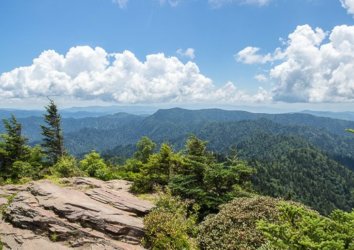The Foothills Parkway in Tennessee is a fabulous drive that traces the northwestern foothills of the Great Smoky Mountains, serving up gorgeous forests and some truly stunning long-range views along the way.
It’s also an incomplete route, with extensive segments with approved right-of-way but not yet constructed. As the National Park Service, which manages the road, notes, the Parkway is “the oldest unfinished highway project in Tennessee” as well as the only one of seven Congressionally authorized parkways that’s uncompleted.
That said, the sections that are finished rank among the prettiest scenic drives in the country, and access some standout attractions that serve as worthy complements to the marvelous sights of the adjoining Great Smoky Mountains National Park. These include dazzling overlooks that, collectively, yield long sightlines southward into the heart of the Great Smokies and northward across the Tennessee Valley and toward the far-off Cumberland Plateau.
Let’s run through where the Foothills Parkway stops and starts, and spell out some of this remarkable in-progress route’s basic details!
A Snapshot History of the Foothills Parkway

Great Smoky Mountains National Park ranks consistently at the top of the most-visited national parks in the country. Its popularity isn’t a recent deal, either. Even in the years before World War II, heavy visitation caused traffic congestion on the park’s main thoroughfares of Newfound Gap Road and Little River Road.
It was partly that congestion—plus the establishment of the Blue Ridge Parkway, which extended to the North Carolina but not the Tennessee side of the Great Smokies—that prompted calls for the creation of a national parkway along the northern fringe of the Smokies.
The official mandate for the creation of this parkway, allowing for donations of land from the State of Tennessee to the Department of the Interior, came from Congress in 1944, calling for “construction of a scenic parkway to provide an appropriate view of the Great Smoky Mountains National Park from the Tennessee side of the park, and for other purposes.”
Construction on this “Foothills Parkway” got underway early in the following decades. The project, which envisioned a 72.1-mile drive weaving through the foothills on the northern side of the Smokies, was split into eight main sections, designated alphabetically from 8A through 8H.
By 1968, some 22.5 miles of the Parkway consisting of sections 8A, 8G, and 8H—including the southwestern and northeastern ends of the route, and the access routes into Great Smoky Mountains National Park known as the Spur and the Gatlinburg Bypass—had been finished.
Funding issues, plus an increasing awareness of (and federal legislation requiring) environmental protection, slowed progress on the Foothills Parkway. So did the topographic and geologic demands of the route, which did, after all, run through some pretty rugged flanking terrain of the main range of the Great Smoky Mountains.
Major progress was made in 2018 with the completion of 16 miles of the Foothills Parkway: sections F and E, technically, between Walland and Wears Valley.
Nowadays, the Foothills Parkway exists as well-loved western and eastern segments welcoming hundreds of thousands of drivers annually. It’s the middle portion—made up of sections 8B, 8C, and 8D—which now remain to be linked up.
The National Park Service manages the Foothills Parkway not as its own standalone unit, but together with Great Smoky Mountains National Park. Given the remarkable views it provides into the park’s high country—and the directly connecting spurs and bypasses that enter this most popular U.S. national park—that certainly seems to make sense.
Where Does the Foothills Parkway Begin? Where Does It End?
![]()
The completed sections of the Foothills Parkway, which add up to just shy of 39 miles, naturally divide it into western and eastern segments. The eastern one, Section 8A, unfurls some 5.6 miles from Interstate 40 to Cosby, Tennessee.
The western segment, comprising sections 8H, 8G, 8F, and 8E, now, with the 2018 work (including completion of the so-called “Missing Link” reach of Section 8E), runs 33 continuous miles. It includes the southwestern terminus of the Foothills Parkway at U.S. 129 and Chilhowee Lake, and stretches to U.S. 321 at Walland and then eastward to Wears Valley.
Until the central sections are completed, therefore, the start and end points of the Foothills Parkway need to be thought of in terms of the two different segments, west and east. The western one connects U.S. 129 in the west and Wears Valley in the east; the eastern segment runs between Cosby in the west and I-40 in the east.
Attractions Along the Foothills Parkway
It’ll be amazing when the entire 72.1-mile ribbon of the Foothills Parkway is a drivable reality. But even with much more work to be done, the sections of the Parkway that are open to the public, which comes strung with established pullouts and overlooks and range through some amazing countryside, are dazzling and well worth checking out.
Along the western segment, for example, you can take a short stroll along the flanks of Chilhowee Mountain to the stunning vantage of Look Rock, topped by an observation tower that yields sightlines between the Cumberland Plateau and the high-standing crest of the Great Smokies.
Along that eastern segment, you can nab amazing looks at the signal peak of 4,928-foot Mount Cammerer, plus the big foothill eminence of 3,629-foot English Mountain, a major regional landmark.
All the segments of the Foothills Parkway, meanwhile, are popular for scenic “leaf-peeping” drives in the autumn, when the edging woods and sweeping overlooks show off the incredible fall foliage the Great Smokies are renowned for.
That said, the Foothills Parkway is a year-round scenic drive with much to recommend it, from the long, luxurious magic hours of summer to the fantastic frosty panoramas of winter. Sightings of wildlife, from white-tailed deer to black bears, are always a possibility.
If you’re visiting Great Smoky Mountains National Park—as, of course, you most definitely should—don’t think of the Parkway as some lesser or secondary attraction: Spare a day to explore its run, and gain whole new perspectives of the park’s superlative landscape—and the broader geographies that enfold it!




